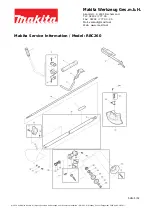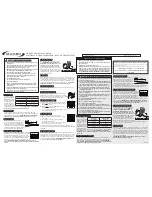
15
GDE 10
Preselecting the speed (Figure J)
To set the operating speed, move the dial to the required value.
Using extension (optional) (Figure K, L)
An extension tube is available for renovation sander GDE 10.
The extension tube can be used to increase the range when
working with the wall sander.
Attach extension tube from below to the housing of the wall
sander
(
1.
)
and push it forwards until it engages
(
2.
)
.
To remove, press in both catches
(
1.
)
and remove exten-
sion tube
(
2.
)
.
Using bar-type handle (optional)
To stabilise the working position, it is possible to mount a bar-
type handle on the handle tube. The mounting position can be
determined individually.
Using adapter for suction hose (optional)
The adapter can be used for connecting suction hoses of differ-
ent dimensions.
Working with the power tool (Figure M)
1. Attach sanding tool.
2. Connect dust extraction system.
3. Insert mains plug.
4. Set required speed.
5. Switch on dust extraction system.
6. Hold the renovation sander with both hands. This
provides the best possible combination of range and
leverage for the application.
7. Switch on the device.
8. Press the wall sander gently against the work surface
(the pressure should be just enough to ensure that the
sanding head is flush with the work surface).
9. Increase pressure to bring the abrasive into contact with
the working surface. In doing so, swing the sander in
overlapping movements to smooth the surface to the
required fineness.
Operating instructions
Brush ring
A brush-type ring surrounds the sanding head. This ring has
two functions:
–
As the ring projects above the surface of the sanding plate,
it is the ring which comes into contact with the work surface
first. As a result, the sanding head is brought parallel to the
work surface before the sanding tool comes into contact
with the work surface.
This avoids a sickle-shaped depression caused by the
edge of the sanding disc.
–
The ring also retains the dust until it is extracted by the dust
extractor.
If the brush ring is damaged or shows excessive wear, it should
be replaced (see section entitled “Maintenance and care”). Re-
placement brush rings are available from any FLEX customer
service centre.
Sanding in dry construction
The renovation sander features a unique swivel head. As this
head can swivel in different directions, the sanding head can
be adjusted to the work surface. As a result, the user can sand
the upper, middle and lower wall areas or ceiling profiles
without having to change his position.
When working, apply only as much pressure on the sanding
head as is required to keep the abrasive in contact with the
work surface. Excessive pressure may result in a disagreeable
spiral pattern of scratches and an uneven work surface.
Move the sander constantly while the sanding plate is in con-
tact with the work surface. In doing so, ensure that you move
the sander evenly and over a wide area.
If you stop the sander on the work surface or move the sander
unevenly, this may result in a disagreeable spiral pattern
of scratches and an uneven work surface.
Maintenance and care
Cleaning
Regularly blow out the housing interior and motor with dry
compressed air.
Regularly clean the filter cover.
Remove filter cover and blow it out with dry compressed
air.
Replacing Velcro or backing pad
Insert the 5 mm hex in the shaft.
Position the pin wrench in the support plate.
Turn the Velcro plate in anticlockwise direction to release
and unscrew.
Mount the Velcro plate in the reverse order of removal.
Replacing the brush ring (Figure N, O)
Remove the sanding head (see section "Attaching/chang-
ing the sanding head (Figure C, D)").
Loosen the three retaining screws.
Take the ring out of the housing.
Insert a new brush ring into the housing and screw in
the retaining screws.
Mount the sanding head in the reserve order of removal.
CAUTION!
Hold the electric power tool with both hands! When working,
always have one hand on the handle – even when working with
attached extension. Keep your hands away from the sanding
head.
Otherwise, your hand could become caught, as the sanding
head swivels in different directions.
CAUTION!
The rotating parts of the DSH-R D150 sanding head must not
come into contact with sharp projecting objects (e.g. nails,
screws, junction boxes). The Velcro pad may be damaged if it
comes into contact with projecting objects.
The Velcro pad can be replaced if it is damaged or severely
abraded (see section entitled “Maintenance and care”).
NOTE
The renovation sander has an overload cutout switch for
protection of the device.
If the load is too great, the device switches off and immediately
restarts.
CAUTION!
In extreme cases in which the sanding head is stopped
abruptly, a coupling is installed in addition.
When this is triggered, the machine must be switched off imme-
diately.
WARNING!
Before performing any work on the electric power tool, pull out
the mains plug.
WARNIING!
Do not use water or liquid detergents.
Summary of Contents for GDE 10
Page 1: ...GDE 10 ...
Page 3: ...3 GDE 10 ...
Page 4: ...4 GDE 10 ...
Page 5: ...5 GDE 10 ...
Page 140: ...140 6 GDE 10 DSH RD150 FLEX P ...
Page 141: ...141 GDE 10 5 FLEX E F G H 1 2 I J L K GDE 10 2 1 1 2 M 1 2 3 4 5 6 7 8 9 ...
Page 143: ...143 GDE 10 3 EN60745 ...
Page 144: ...144 2 GDE 10 ...
Page 145: ...145 GDE 10 1 7 GDE 10 1000 FLEX GDE 10 M ...
Page 146: ...504 424 07 2021 Für Druckfehler keine Gewähr Technische Änderungen vorbehalten ...
















































